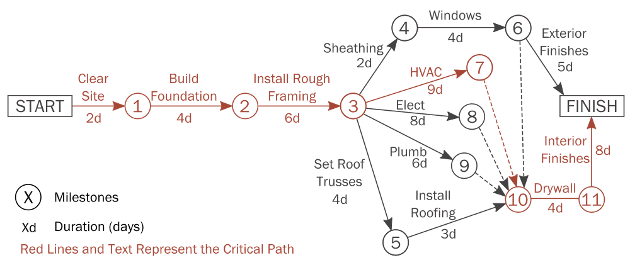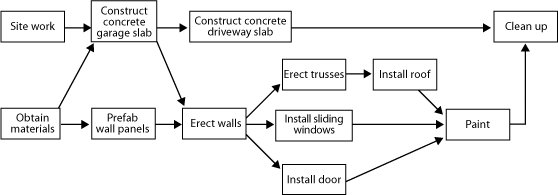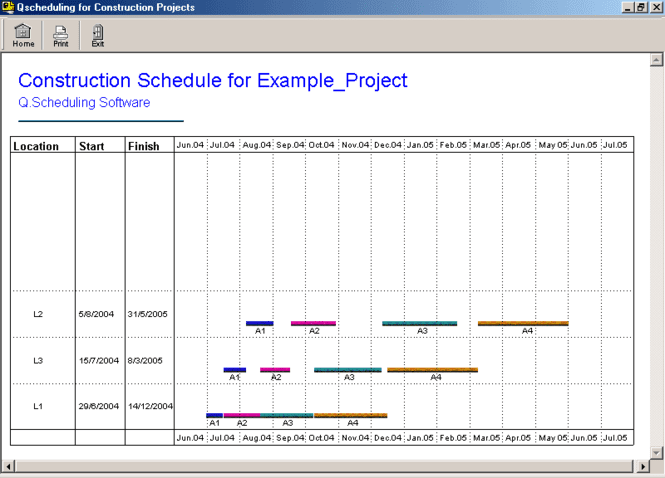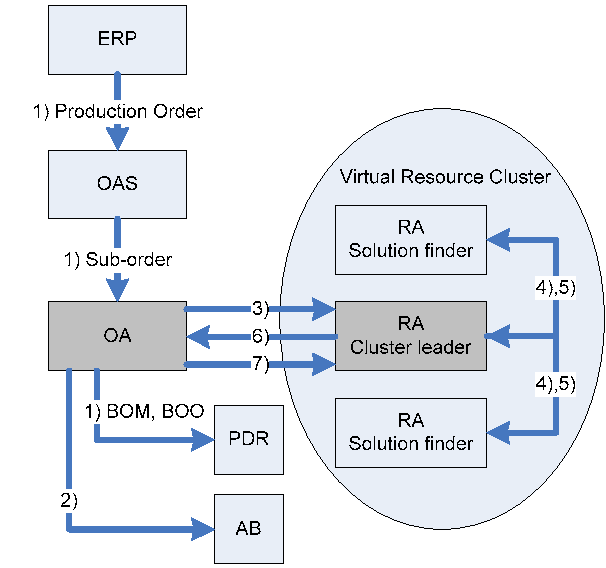Help us improve your experience. See content that is made for you!
See how IBM increased their efficiency by up to 30%!

Help us improve your experience. See content that is made for you!
See how IBM increased their efficiency by up to 30%!


Construction scheduling is one of the most complex project activities. Schedule overruns are incredibly common, especially as construction projects get larger. According to research, large commercial construction and infrastructure projects typically take 20% longer to finish than scheduled and KPMG estimates that only 25% of projects are completed within 10% of their intended schedule.
Choosing the best construction scheduling method and tools for your project is clearly essential -- but where do you start? Today, we walk your through all things scheduling.
What we cover:
A construction schedule is a complete breakdown of all project tasks and deliverables, sequences, and corresponding activities. The two key components of a construction schedule involve stakeholders performing the work and resources needed to complete the work.
There are two main types of schedules on projects:
A master schedule is the highest level schedule in project management identifying a project’s major deliverables and milestones by date.
In construction project management, the general contractor would likely use a master schedule to track progress through each phase of construction including delivery and handover. The master schedule is often communicated to other stakeholders like project owners and subcontractors so project progress can be monitored and executed against by teams in the field and office.
A project schedule is a resource for teams where every task that needs to be completed for a project is organized in a logical sequence. This is more specific than a high-level master schedule. In a project schedule, it’s common for certain tasks or milestones to rely on the completion of dependencies before moving onto the next task. A project schedule commonly appears in the form of a Gantt chart.
Project leaders use the project schedule to monitor and adjust scheduled tasks to stay on budget as much as possible.
As hard as we try to stay organized, construction scheduling will always pose a challenge–one of the biggest on any project. There are thousands, if not millions, of details to track per project, from supplies to staff hours to promises made and roles played. The right scheduling method (or the wrong one) can make all the difference between meeting deadlines and budgets. On the one hand, a wrong choice could equate to mistakes, rework, risk, and more.
Which leads us to an obvious question: What construction project scheduling technique and tools should you be using?
Unfortunately, there’s no one right answer in the construction industry broadly. Each approach and strategy comes with its pros and cons, into which today’s post will take a deep dive. Nor is one tool necessarily enough. Each project is unique, and its scheduling method can vary so your team might need to use a combination of tools.
With that in mind, let’s examine seven of the most popular construction scheduling tools and strategies. No matter which method ends up working best for you, we can guarantee that educating yourself about these tools will make a significant difference in your productivity, communication, and ability to move beyond good enough and reach for great.
All it takes is finding the right fit for your team and projects. Let’s get started.

Perhaps the most widely used construction scheduling method in large projects, the Critical Path Method (CPM) holds that “your ability to complete any activity hinges on a few critical resources or constraints,” according to Workamajig.
In one of the best metaphors of all time, they illustrate this concept using a sandwich, explaining that “you might have all the butter, ham, and cheese you need, but if you don’t have bread, you can’t make a sandwich. The bread, in this case, would be the constraint your sandwich-making project depends on.”
Due to the critical importance of constraints, project managers study CPM scheduling as part of their Project Management (PMP) certification. Also, for this reason, it’s the legal standard for measuring delays when it comes to project-related disputes.
According to The Balance, CPM “generates a graphical view of a project and calculates how much time and resources are required to complete each activity. It also determines critical activities requiring attention so that the project can be completed on time.”

Photo courtesy: Archtoolbox
PERT is one of the most visually accessible construction scheduling tools. Essentially, it is a diagram that “provides a visual depiction of the major project activities and the sequence in which they must be completed.” Each of these steps represents the use of time or resources or both. Think of it as a road map toward project completion; only once you pass all of the milestones will the building have reached its final stages.
As Harold Kerzner explains in Project Management, “PERT charts are often constructed from back to front because, for many projects, the end date is fixed and the contractor has front-end flexibility.”

Photo courtesy: Built Right
This construction scheduling tool rests on the thoughtful planning of projects through repeated iterations. As Designing Buildings explains, “Line of balance (LOB) is a management control process … where the project contains blocks of repetitive work activities, such as roads, pipelines, tunnels, railways, and high-rise buildings. LOB collects, measures, and presents information relating to time, cost and completion, and presents it against a specific plan.”
LOB helps to pinpoint where projects go off-track but identifying the specific moments at which deviations occur, and the resulting knock-on or secondary effects that accrue from them. It was developed by the Goodyear Company and has since been used by the Navy, and reflects project goals as a single line on a graph in the form of activities completed/time, to which teams are supposed to adhere to stay on track.

Photo courtesy: Planning Engineer
Also known as quantitative scheduling or queue scheduling, this construction scheduling approach “uses a bar chart format to indicate quantities of materials that will be used at different locations and at different times during the project,” explains Sobieski.
With this type of scheduling, companies can see clearly “the amount and type of material that will be needed at various times and physical locations.” It also wraps in a hierarchical component, so workers and managers can see which materials they need at which times, order them accordingly, follow tasks in sequence and avoid disrupting other’s work–all while tracking costs along the way.

Photo courtesy: planning & consulting
Simply put, this construction scheduling method centers around the project’s resources, prioritizing the most efficacious use of those resources. As BrainKart explains, limited resources make it likelier that delays will occur as various teams jockey for those resources. Without a smart approach to who receives them and when a construction company may find itself dithering or wallowing in its inability to assign priority.
Resource Oriented Schedule takes into account all who will need the resources ahead of time, then assigns their use in an orderly fashion throughout the life of the project. That might mean space, machinery, labor, or anything else that is in limited supply but highly desirable to project teams.

Photo courtesy: Bridging the gap between centralized and distributed manufacturing execution planning
The Last Planner System is less a construction scheduling tool and more a short-term collaborative planning process. Although it is not a tool in its own right, it can work well with construction schedule techniques like CPM.
In a nutshell, “LPS brings together those who will execute the work (the team) to plan when and how work will be done through a series of conversational processes.” In so doing, teams can assess the likely roadblocks beforehand and remove them, thereby encouraging the timely completion of each task.

Photo courtesy: Lean Construction Institute
A Gantt Chart is another construction scheduling tool, rather than a technique. It is a type of bar chart that encourages stakeholders to structure the project with several levels of details and consider dependencies between tasks. This helps them estimate the duration of the project and identify the critical path to take during construction.
“A Gantt chart is a bar chart used to illustrate a construction project schedule, that includes some milestones and it is not as detailed as a full CPM,” explains The Balance, adding that “It normally includes start/end dates of activities and a summary of activities of a project.” However, it lacks the complexity of more comprehensive approaches and doesn’t include the resources or materials needed to complete it.
Gantt Charts are excellent for creating a hierarchy among projects, showing which ones require immediate attention and which must be completed before other, dependent projects can follow.

Photo courtesy: Gantt Excel
The construction schedule is often the first piece of documentation an owner receives demonstrating the contractor’s professionalism in planning and construction management, so it’s key to establishing credibility in an increasingly competitive field. Here are five common project scheduling mistakes that, when corrected, can help improve your company’s success rates and reputation.
To ensure your project is set up for success from the beginning, it’s important to be as accurate as possible about project deadlines during the preconstruction process.
Estimating the project accurately can even be started in the RFP process. This is the opportunity where architects, contractors, and owners can express their concerns over the budget and timelines of the project. If either of the parties appears to be unrealistic about timing or budget, this should be an immediate red flag that the project is heading straight for an overrun.
Thorough, realistic estimation and planning will help you avoid scheduling issues down the line, so be willing to listen and adjust course if project stakeholders express concern over timelines.
Watch more:
The worst thing you can do to your project team is print out a paper schedule or give them a static PDF and expect your crew to sift through the mass amount of data to figure out what needs to be done and when. Causing them to work from outdated milestones and timelines. Not catching the handoffs that need to happen from one activity to another to keep the project running smoothly.
If not properly defined from the get-go, missing dependencies can lead to more than just overshooting deadlines: you could have difficulty arguing fault during litigation, arbitration, or lawsuit. For example, wall foundations have to be constructed before the walls themselves, and that must be properly represented on the project schedule. It may seem like a no-brainer, but in a complex project, it’s easy to overlook these types of mistakes. To avoid delays, construction schedules should be continually checked by multiple stakeholders to ensure all dependencies are in the proper, logical order.
Every company has a set amount of resources available for any given project, whether that’s time, budget, materials, or manpower. Problems and delays often occur when schedules are set in place with the assumption that there are unlimited resources at your disposal. According to research, 68% of trades point to poor schedule management as the key contributors to decreased labor productivity.
When creating your schedule, maintain a realistic sense of what you’ll have to work with at any given time, and be sure to remember external factors that could impact your resources, like material shortages.
Speaking of material shortages — there are a lot of factors on the job site you simply can’t control. That’s why on projects where just about anything can happen, overseeing construction schedules is a role best suited for the overly cautious. Always plan for the worst-case scenario, allocate extra funds, and include buffer time to handle the unknowns that will most likely impact a build, like potential weather delays.
Today, there exist many technology platforms and tools that are designed to streamline construction project scheduling without necessitating that you create new workflows from scratch. The benefits of using construction scheduling software include:
This isn’t to say all construction software is created equal, though. There are many options, and no one right answer for your team and project needs. Before you plunk down your cash and commit to a long-term subscription, there are a few essential qualities to consider. Any good project scheduling tool should be:
Here’s where some companies get stuck: getting started. While it’s great that there are so many options.. It can be hard to sort out which ones will work for you, integrate them into your workflow, and get everyone to adopt them – and that’s just one new method, let alone several.
The antidote to analysis paralysis? Choose a single method, the one most likely to make a difference in your project workflows right away, and implement it. It might take a while to do this right, so give yourself the time, but set a deadline and make it happen. Make sure to:
Doing the above won’t necessarily make the transition seamless, but it will undoubtedly smooth the way and help ensure that your workers feel valued. With their input and buy-in, you’re much likelier to succeed with your new project scheduling methods.
Interested in exploring more about construction project scheduling software? Learn more about the benefits of Autodesk Construction Cloud.

May we collect and use your data?
Learn more about the Third Party Services we use and our Privacy Statement.May we collect and use your data to tailor your experience?
Explore the benefits of a customized experience by managing your privacy settings for this site or visit our Privacy Statement to learn more about your options.